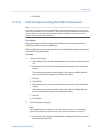
12.26 Check the drive gain
Excessive or erratic drive gain may indicate any of a variety of process conditions, sensor
problems, or configuration problems.
To know whether your drive gain is excessive or erratic, you must collect drive gain data
during the problem condition and compare it to drive gain data from a period of normal
operation.
Excessive (saturated) drive gain
Possible causes and recommended actions for excessive (saturated)
drive gain
Table 12-8:
Possible cause Recommended actions
Slug flow Check for slug flow. See Section 12.25.
Partially filled flow tube Correct process conditions so that the flow tubes are full.
Plugged flow tube Check the pickoff voltages (see Section 12.27). If either of them are
close to zero (but neither is zero), plugged tubes may be the source
of your problem. Purge the tubes. In extreme cases, you may need
to replace the sensor.
Cavitation, flashing, or air en-
trainment; settling of two- or
three-phase fluids
• Increase the inlet or back pressure at the sensor.
• If a pump is located upstream from the sensor, increase the dis-
tance between the pump and sensor.
• The sensor may need to be reorientated. Consult the installa-
tion manual for your sensor for recommended orientations.
Drive board or module failure Contact Micro Motion.
Bent flow tube Check the pickoff voltages (see Section 12.27). If either of them are
close to zero (but neither is zero), the flow tubes may be bent. The
sensor will need to be replaced.
Cracked flow tube Replace the sensor.
Sensor imbalance Contact Micro Motion.
Mechanical binding at sensor Ensure sensor is free to vibrate.
Open drive or left pickoff sen-
sor coil
Contact Micro Motion.
Flow rate out of range Ensure that flow rate is within sensor limits.
Incorrect sensor characteriza-
tion
Verify the characterization parameters.
Erratic drive gain
Possible causes and recommended actions for erratic drive gainTable 12-9:
Possible cause Recommended actions
Wrong K1 characterization constant for sensor Verify the K1 characterization parameter.
Troubleshooting
Configuration and Use Manual 239


















